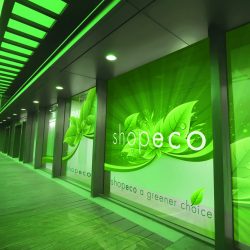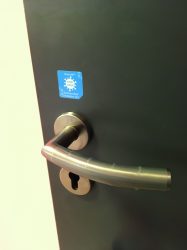One sector that’s seen radical change over the last year is substrates, with the Coronavirus outbreak driving both demand for and development of materials to help deal with the pandemic. From signage and distancing to virus-killing laminates, Michael Walker takes stock
We’ve reported extensively in recent months about the negative effects of the Covid pandemic on printers, especially those serving the events and retail sectors, many of whom have pivoted to producing PPE or signage and spacing / social distancing products. While some of these products required existing materials – non-slip printable floor graphics being a notable one, for social distancing and one-way signposting in queues and retail stores, for example – and demand at some points last year seemed to outstrip supply, we’ve also seen a sustained development effort by the substrates suppliers to come up with materials that either kill germs directly, or that can withstand frequent cleaning with solutions that do.
John Vic, sales director, digital media at Premier Paper comments, ‘Throughout the Covid-19 pandemic Premier Paper has seen an increase in demand for signage, synthetic and self-adhesive products driven primarily by the growing requirement for more hygienic, high clarity communications to help government, businesses, hospitals, schools and local councils to instruct, inform, and guide the public as well as their staff.

Drytac’s SpotOn SynTac is easily installable and removable and can be printed with a variety of digital ink types
‘One such product is DigiTuff, a durable synthetic media produced in the UK that can be cleaned with bleach and alcohol. This sheet has provided the perfect answer to restaurants and shops, even airlines for printed media such as menus and manuals that can be easily cleaned after use, with no need for unnecessary reprints or lamination.’
Mr Vic also mentions Teslin, another synthetic paper that has been in demand during the pandemic. While not as durable as DigiTuff, it has a biodegradable version which is said to reduce environmental impact, an ongoing concern with plastic-based materials. Another option from Premier is Synaps, a synthetic white opaque film from Agfa, which Mr Vic says has been popular for its durability and resistance to water and tearing. There are versions for both dry and liquid toner presses, and the most recent addition, Synaps XM110, is a 100-micron version intended for ticketing and signage amongst other applications. It’s available in rolls and sheets.
Premier has also just taken on the Folex Digiprint IG range of materials for sheet-fed HP Indigo presses in both SRA3 and B2 sizes. These include clear, gloss white, silver and translucent polyesters, plus clear and white window cling and a dry-apply window tack grade to support growing interest in window graphics. Mr Vic notes the convenience of ordering all media for digital print from one source ‘one delivery, one set of paperwork’.
One manufacturer that’s been busy over recent months is Kernow Coatings which has launched Kernow Print Dry Toner Matt Pro Antimicrobial. This resists bacterial growth and is suggested for applications such as printed materials and signage in hospital and healthcare environments, as well as protection for menus in restaurants and coffee shops, though there isn’t currently much demand for those under current UK lockdown rules. There is also a labelstock version which works with a variety of print technologies.
Looking down, Kernow’s FloorShark Dry Toner has R10 certified slip resistance and is suited to all kinds of indoor environments, including low pile carpet tiles, from which it can be removed without residue. Its outdoor complement is the forthcoming RoadShark K200XFG which has a more aggressive texture and R12 outdoor anti-slip certification, good for three to six months use. It’s printable with solvent or latex inks. On the PPE side, Kernow has also developed KlearVisor 180KVAF for reusable face shields used across a wide range of retail and hospitality settings. It has an anti-fog coated side which can be cleaned in accordance with hospital guidelines.
Drytac also offers an antimicrobial material, Protac AMP, a 150-micron PVC-free surface protection film that uses Microban antibacterial technology to prevent mould and bacterial growth, including MRSA. It too was launched during the pandemic, to help meet the need for increased hygiene in public and healthcare settings.
For safety-related graphics, Drytac launched SpotOn SynTac for floor and wall applications, also PVC-free, and printable with aqueous, (eco) solvent, latex and UV inks. Available in roll widths up to 1370mm, it has a dot pattern polyacrylate adhesive for easy installation that can be removed cleanly within 12 months.
Ashgrove Trading has also noted the demand for signs, notices and documents that can be wiped and cleaned, and offers Picofilm, a dry toner printable pure polyester sheet that according to the company’s Rolf Smith has been proven by testing to be highly resistant to disinfectants, and to pass infection control standards in medical environments. Mr Smith lists applications as customised signs and notices for offices, surgeries, shops and construction sites. It’s available in sizes from A4 to SRA3.
Another product that Ashgrove has seen flying off the shelves is UPM’s Mastertac SRA3 self-adhesive digital range. Available for both dry and Indigo toner presses, it’s tearproof, waterproof and washable when printed, with a removable version for temporary indoor signage and an ‘extra permanent’ version for outdoor use that has split backing paper for easy removal.
Perspex hasn’t developed antimicrobial materials, mainly because demand has soared for its regular range of clear cast acrylics, resulting in a 300% increase in production in 2020, for use as physical screens, while its ‘print’ materials that have been used for partitioning and in the production of hand sanitising stations. Marketing manager Luke Martyn points out that many of the firm’s UK-produced thermoplastics have good chemical resistance that makes them suited to installations where regular cleaning is required.
Other lines from Perspex Distribution that are being used for niche display solutions include Multishield magnetic panels and a fire retardant version of Alupanel aluminium sheets, which along with the company’s other printable media have been given a Signal White finish.
Fire resistance is also a key characteristics of Ignisafe, a satin paper suitable for poster, PoS and signage printing with (eco)solvent, UV and latex inks. The 150gsm paper from French manufacturer Guyenne Papier is designed for indoor advertising environments and meets the M1 fire resistance standard.
Guyenne also offers a synthetic non-woven fabric for the same ink types, Decolov M1. It suits similar applications – plus wall decoration – and has the same fire retardancy certification, with the added benefits of being tear and crease-resistant. It can be sewed, welded or fitted with eyelets and has good acoustic absorption properties.
Another French manufacturer, Arjobex, produces the Polyart synthetic paper, with which it has an established presence in narrow-web label applications, where in combination with suitable adhesive it passes the BS5609 standard for marine labelling. The company’s cut-sheet range for dry and liquid toners is now being expanded with the introduction of a single-sided 180gsm version for inkjet presses with aqueous inks, which has been successfully tested with the Fujifilm JetPress.
Global marketing director Louis Rouhard told Digital Printer that producing an economically viable two-sided version is the current challenge, as the multi-stage coating process needed to make inkjet inks stick to polyethylene pushes costs ‘through the roof’. He’s optimistic that further investment will crack this.

Coala Coversafe has been shown in lab tests to rapidly inactivate SARS-CoV 2
Anti-bodies
There’s been understandable confusion about the exact properties of various materials that are marketed under the ‘antimicrobial’ tag. In the same way that well-known brands of domestic cleaning products claim to kill 99% of ‘germs’ (and thus drive the evolution of potentially more dangerous resistant species such as MRSA), the word ‘microbes’ covers quite a few different things, from parasites and fungi to bacteria – such as E. Coli or legionella – and viruses, such as those that cause the common cold, all varieties of influenza, and of course, Covid-19, or to give it its full scientific name, SARSCoV-2.
Depending what you’re doing and who it’s for, it’s important to be clear on these distinctions. At the time of writing, Digital Printer was aware of only two materials that specifically kill (or ‘inactivate’, as it’s debatable whether viruses are truly alive) the Covid-19 virus.
One was released by InkTec Europe in August 2020 and was confirmed by lab testing of various surfaces in October to inactivate the virus in four hours. It’s a copper-based film that is available in 50cm x 30m rolls and suited for use on frequently touched surfaces such as door handles, touchscreens, counters, public transport vehicles and ticket machines and power switches.
A more recent addition that appeared in late January 2021 comes from Antalis. Coala Coversafe is a transparent antimicrobial adhesive film that uses technology developed by French firm Pylote that reduces the SARS-CoV 2 viral load by 96% after one hour’s contact. Testing in real-world school conditions showed a decrease in ‘total flora’ – that is, any of the types of ‘microbes’ described above, not just viruses or the Covid virus specifically – by a factor of two to four. Coala Coversafe is available in rolls and can be cut to size for non-flat surfaces like door handles.
‘In the context of this ongoing health crisis, we are delighted with the success of the results of these tests which demonstrate the effectiveness of Coala Coversafe against the strains responsible for Covid-19 and other microbes. This innovation allows us to offer our customers, and their clients, a solution that allows them to continue their activities with improved protection,’ said Mike Collins, product manager at Antalis.
This doesn’t mean that antimicrobial products with no specific or tested capability against Covid-19 are not useful. Given the burden on UK hospitals caused by the second wave of the pandemic, no one wants or needs to get ill with anything else either, so anything that raises general standards of hygiene in communal or public areas is still a good idea. Various antimicrobial or antibacterial materials are listed in the main text of this article.
Shaun Holdom, global product manager at Drytac, adds, ‘Perhaps most important when seeking out antimicrobial protection is to be extremely wary of some of the claims currently being made in the marketplace. New disinfectant and additives used within antimicrobial solutions must have ECHA (European Chemicals Agency), EPA (United States Environmental Protection Agency) and FDA (Food and Drug Administration) approval to make valid effectiveness claims; all biocides and pesticides have to be registered.’
Mr Holdom points out that scratches or cuts in films that arise in handling, installation or use can harbour bacteria so it’s important that antimicrobial or antibacterial additives are present throughout the film’s material and not just as a layer coated on top of it. He also warns that anti-virus tests are specific to strains of virus and so effectiveness against one variety does not imply effectiveness against others – so read the small print.
If you’re wondering what role there is for good old fashioned paper in all of this, the good news is that tests reported by print advocacy group Two Sides suggest that the Covid virus becomes non-infectious after only three hours on paper and tissue, so clients buying print on regular stocks shouldn’t need to worry. It actually survives longer on plastics, though printing processes on any substrate also reduce its effective lifespan.





